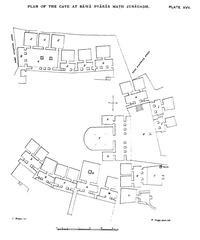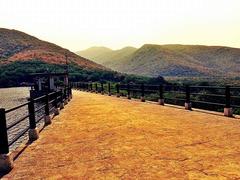Comprehensive Guide to Visiting Bahauddin Maqbara, Junagadh, India
Date: 18/07/2024
Introduction
Bahauddin Maqbara, a magnificent mausoleum located in Junagadh, Gujarat, India, stands as a testament to the region’s rich cultural and architectural heritage. Constructed in the late 19th century during the reign of Nawab Mahabat Khan II, this iconic monument was built to honor Bahaduddinbhai Hasainbhai, a revered minister in the Nawab’s court. The maqbara’s intricate design, which blends Indo-Islamic, Gothic, Mughal, and European architectural styles, has made it a popular destination for tourists, historians, and architecture enthusiasts alike. Often compared to the Taj Mahal due to its symmetrical layout and use of white marble, Bahauddin Maqbara offers a unique visual feast with its detailed carvings, elaborate arches, and panoramic views from its minarets (source). This comprehensive guide aims to provide visitors with an in-depth understanding of the maqbara’s historical significance, architectural features, visitor information, and nearby attractions, ensuring a memorable and respectful visit to this remarkable site.
Table of Contents
- History of Bahauddin Maqbara, Junagadh, India
- Visiting Information
- Preservation and Restoration
- Cultural Impact
- Nearby Attractions
- FAQ
- Conclusion
History of Bahauddin Maqbara, Junagadh, India
Origins and Construction
Bahauddin Maqbara, also known as the Mausoleum of Bahaduddinbhai Hasainbhai, was constructed around 1891 during the reign of Nawab Mahabat Khan II. The maqbara was built to honor Bahaduddinbhai Hasainbhai, a significant minister in the Nawab’s court, reflecting the architectural grandeur and cultural amalgamation of that period.
Architectural Style
The Bahauddin Maqbara is an exquisite example of Indo-Islamic architecture, with a blend of Gothic, Mughal, and European styles. The structure is renowned for its intricate carvings, elaborate arches, and detailed minarets. Built using local sandstone and marble, the maqbara features a central dome flanked by four smaller domes, adorned with delicate latticework and floral motifs. Its design is often compared to the Taj Mahal due to its symmetrical layout and use of white marble. However, it stands out with unique elements like Gothic-style windows and European-inspired balustrades. The minarets, with their spiral staircases, offer panoramic views of the surrounding city.
Historical Significance
The Bahauddin Maqbara holds immense historical significance as it represents the cultural and architectural heritage of Junagadh. It is a testament to the artistic and engineering prowess of the craftsmen of that era and reflects the influence of various architectural styles prevalent in India during the late 19th century. The maqbara symbolizes the high regard in which Bahaduddinbhai Hasainbhai was held by the Nawab and the people of Junagadh.
Visiting Information
Bahauddin Maqbara Visiting Hours and Tickets
The Bahauddin Maqbara is open to visitors from 9:00 AM to 6:00 PM daily. There is no entrance fee, making it accessible to everyone interested in exploring this historical monument. However, donations for the upkeep of the maqbara are appreciated.
Visitor Tips and Best Time to Visit
The best time to visit the Bahauddin Maqbara is during the cooler months, from October to March, when the weather is pleasant. Tourists are advised to wear comfortable footwear as the exploration involves climbing stairs and walking through narrow passages. Photography is allowed, and visitors are encouraged to capture the stunning details of the carvings and the panoramic views from the minarets.
Preservation and Restoration
Over the years, the Bahauddin Maqbara has faced several challenges in terms of preservation and maintenance due to natural wear and tear and environmental factors. Efforts by the Archaeological Survey of India (ASI) and local authorities have been made to restore and preserve the maqbara. Initiatives to promote the maqbara as a tourist destination have helped generate funds for its maintenance, including cleaning intricate carvings, repairing damaged sections, and ensuring structural stability.
Cultural Impact
The Bahauddin Maqbara is a cultural landmark in Junagadh, attracting tourists, historians, and architecture enthusiasts from all over the world. It serves as a reminder of Junagadh’s rich cultural heritage and the contributions of its rulers and ministers. The monument’s unique architectural style and historical significance make it a popular subject for academic research and study.
Nearby Attractions
While visiting the Bahauddin Maqbara, tourists can explore other historical sites in Junagadh, such as the Uparkot Fort, Mahabat Maqbara, and Girnar Hill. These attractions offer a deeper insight into the region’s rich history and cultural heritage.
FAQ
What are the visiting hours for Bahauddin Maqbara?
The Bahauddin Maqbara is open from 9:00 AM to 6:00 PM daily.
How much are tickets for Bahauddin Maqbara?
There is no entrance fee for visiting the Bahauddin Maqbara. However, donations for maintenance are appreciated.
What are some nearby attractions to Bahauddin Maqbara?
Nearby attractions include Uparkot Fort, Mahabat Maqbara, and Girnar Hill.
Conclusion
In conclusion, Bahauddin Maqbara is a remarkable historical monument that offers a glimpse into the rich cultural and architectural heritage of Junagadh. Its unique blend of architectural styles, historical significance, and cultural impact make it a must-visit destination for anyone interested in India’s history and heritage. Don’t forget to explore the nearby historical sites to complete your visit to Junagadh. For more information, visit the Archaeological Survey of India or contact local guides for detailed insights.
Call to Action
To stay updated on more historical sites and travel tips, download our mobile app Audiala, check out other related posts, or follow us on social media.

